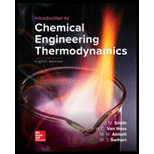
Interpretation:
The enthalpy and entropy changes accompanying the change in the state of steam should be calculated based on the steam table data and by considering steam to behave as an ideal gas.
Concept Introduction:
- Enthalpy (H) and entropy (S) are state functions in that they can be defined by two parameters for example, temperature and pressure. When a system changes from state 1 to state 2, the change in enthalpy △H and the change in entropy △S can be given by the difference in the values in the two states, i.e.
- For an ideal gas the corresponding △H and △S can be given as:
Based on the steam table data:
△H =
△S =
Based on the ideal gas assumption:
△H = 270.2 Btu/lbm
△S = 0.517 Btu/lbm-F
Given:
Mass of steam, m = 1.0 lbm
Pressure of saturated vapor = 20 psi
Pressure of superheated vapor = 50 psi
Temperature of superheated vapor =
Explanation:
The initial state of steam is saturated vapor and the final state is superheated vapor. Thus the enthalpy and entropy changes can be given based on equations 1 and 2 as:
These values can be obtained from steam tables
Calculation:
Based on the steam tables, for saturated vapor at P = 20 psi
Tsat =
Again from the steam tables, for the superheated vapor at T =
Therefore,
Based on the ideal gas assumptions using equations (3) and (4) we get:
The values of the change in enthalpy and entropy are as follows:
Based on the steam table data:
△H =
△S =
Based on the ideal gas assumption:
△H = 270.2 Btu/lbm
△S = 0.517 Btu/lbm-F
Trending nowThis is a popular solution!

Chapter 6 Solutions
Introduction to Chemical Engineering Thermodynamics
 Introduction to Chemical Engineering Thermodynami...Chemical EngineeringISBN:9781259696527Author:J.M. Smith Termodinamica en ingenieria quimica, Hendrick C Van Ness, Michael Abbott, Mark SwihartPublisher:McGraw-Hill Education
Introduction to Chemical Engineering Thermodynami...Chemical EngineeringISBN:9781259696527Author:J.M. Smith Termodinamica en ingenieria quimica, Hendrick C Van Ness, Michael Abbott, Mark SwihartPublisher:McGraw-Hill Education Elementary Principles of Chemical Processes, Bind...Chemical EngineeringISBN:9781118431221Author:Richard M. Felder, Ronald W. Rousseau, Lisa G. BullardPublisher:WILEY
Elementary Principles of Chemical Processes, Bind...Chemical EngineeringISBN:9781118431221Author:Richard M. Felder, Ronald W. Rousseau, Lisa G. BullardPublisher:WILEY Elements of Chemical Reaction Engineering (5th Ed...Chemical EngineeringISBN:9780133887518Author:H. Scott FoglerPublisher:Prentice Hall
Elements of Chemical Reaction Engineering (5th Ed...Chemical EngineeringISBN:9780133887518Author:H. Scott FoglerPublisher:Prentice Hall
 Industrial Plastics: Theory and ApplicationsChemical EngineeringISBN:9781285061238Author:Lokensgard, ErikPublisher:Delmar Cengage Learning
Industrial Plastics: Theory and ApplicationsChemical EngineeringISBN:9781285061238Author:Lokensgard, ErikPublisher:Delmar Cengage Learning Unit Operations of Chemical EngineeringChemical EngineeringISBN:9780072848236Author:Warren McCabe, Julian C. Smith, Peter HarriottPublisher:McGraw-Hill Companies, The
Unit Operations of Chemical EngineeringChemical EngineeringISBN:9780072848236Author:Warren McCabe, Julian C. Smith, Peter HarriottPublisher:McGraw-Hill Companies, The





